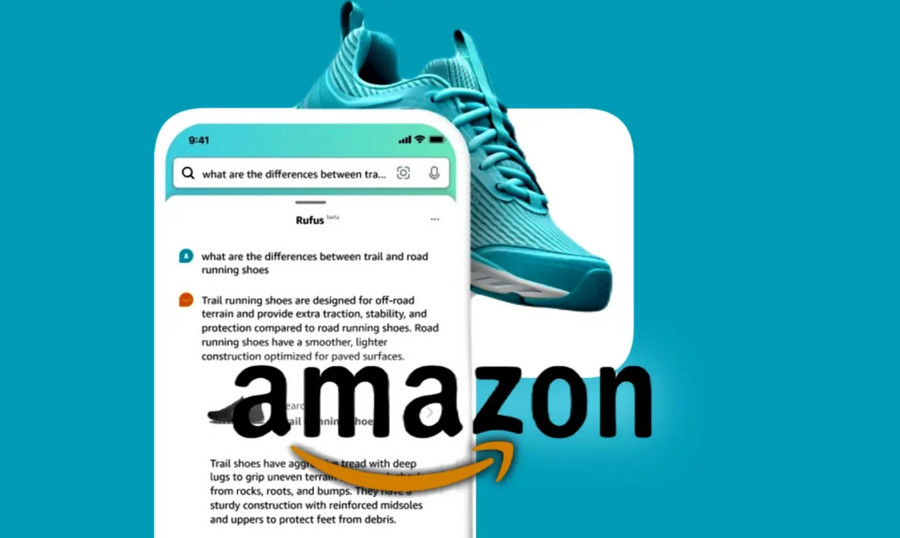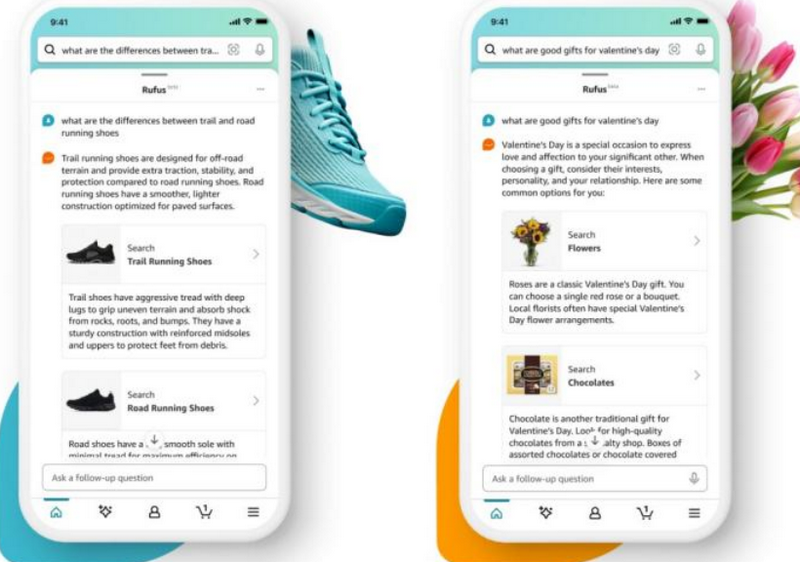
Newsletter abonnieren
Geben Sie unten Ihre E-Mail-Adresse ein und abonnieren Sie unseren Newsletter

Geben Sie unten Ihre E-Mail-Adresse ein und abonnieren Sie unseren Newsletter

Since the emergence of Chat GPT, “AI e-commerce” has become the new hope for major e-commerce platforms. Under intense competition from Temu, TikTok, and SHEIN, Amazon has proactively reduced commissions in the apparel category (one of the top three categories) and has placed heavy bets on AI, viewing it as a key to maintaining its leading position.
In April 2023, Amazon CEO Andy Jassy stated in a shareholder letter that Amazon is heavily investing in large language models and generative AI, which will be the core of Amazon’s innovation in various businesses and fields in the coming decades, changing and enhancing almost all user experiences. This means that Amazon will not rest on its laurels in the “search e-commerce” domain. In fact, it has already taken several crucial steps, focusing on self-renewal, aiming to substantially change the entire platform’s ecosystem.
In the future, Amazon’s KI-Tools will become new traffic gateways, leading to a significant decrease in traffic from buyers entering product pages through the search box using “keyword search.” For sellers, the traditional operational logic around “search e-commerce” will undergo significant changes. If sellers do not closely follow Amazon’s AI traffic entrance for new layout adjustments, including in product titles, A+, descriptions, and more, their traffic will decrease significantly, falling behind their peers.
Over the past year, Amazon has used AI technology to transform many products, including voice assistants, image search, and has launched three major AI features:
Among them, the field of buyer reviews is the biggest test ground for Amazon AI.
Recently, Amazon has launched an AI tool that could fundamentally change the platform’s traffic pattern—Rufus. It is essentially an “e-commerce scenario Chat GPT,” using generative artificial intelligence technology to help customers choose and buy products in a “question-and-answer” manner. Rufus’s most important feature is “instantly answering buyer’s questions,” helping them “search for products,” “discover products,” “research products,” “filter products,” and guide them to purchase certain types or specific items.

Rufus’s entrance is very prominent, located in the search box at the top of the Amazon shopping app. Currently, in some buyers’ search boxes, not only does it display “Search Amazon,” but also “Ask a question,” which is Rufus’s new entrance. This is a new traffic entrance different from the main function of “search.” Through this entrance, buyers can use “chat” to let Rufus help them find products, and even ask very detailed or vague product questions, such as, “My mother is 5.5 feet tall, weighs 120 kg, likes red, please recommend a set of Christmas dresses and shoes for her,” and so on.

When Rufus receives a buyer’s question, it will immediately crawl Amazon category nodes, past buyer comments, Q&A, internet information, etc., to provide detailed answers and recommendations. Additionally, Rufus has other entrances. For example, after a buyer enters a specific product page and is too lazy to look at the product details page or the densely packed comments left by past buyers, they can also ask Rufus.
For example, a customer browsing a page sees a sports shirt, becomes interested in the product, but does not know much about it, can ask Rufus: “Is this shirt made of thick material?” “Is this sports shirt suitable for running?” or “Is it fitting for a person who is 6 feet 7 inches tall?” Rufus will provide detailed answers. For example, in response to the last question “Is it fitting for a person who is 6 feet 7 inches tall?” Rufus will reply: “There is no indication in the product description that this piece of clothing is suitable for the tallest height. However, based on some customer comments, it can be found that a person who is 6 feet 7 inches tall can fit into this clothing.”

Of course, Rufus will also give “independent judgments” based on its analysis and “persuade” buyers to leave. For example, regarding an electric bicycle, a buyer asks, “Is this bike suitable for a romantic date?” Rufus, after comparing the product descriptions and user comments of various types of bicycles on the site (and may also compare external information), replies, “Although electric bicycles are fun for dating activities, they may not provide an intimate or romantic date feel. Consider more traditional leisure beach bikes or tandem bicycles, which may offer a more romantic riding experience.” This answer is likely to deter the customer.
It can be foreseen that Rufus’s impact on buyers’ shopping decisions will become increasingly significant. Therefore, sellers need to make new traffic layouts around this change.
The launch of Rufus may cause a change in Amazon’s entire ecosystem and to some extent, overturn the operational logic of traditional search e-commerce:
In the past, the search box was Amazon’s largest traffic entrance. After the launch of Rufus, it will become a new traffic entrance. Many users will not only use the search box to search for products but also discover products or get very specific advice through Rufus. For example, “Outdoor sports, what headphones are suitable?” “What is a good birthday gift for a 50-year-old father?” “My girlfriend is a junior student, what is the best Thanksgiving gift for her?” From now on, Rufus is not just a search tool but becomes a “private chat friend” that provides shopping guides. It also creates a new shopping scenario, tentatively referred to as the “Rufus question and answer shopping scene.”
Additionally, when customers enter a product page, they may no longer look at the number of reviews for that product or browse through the comments left by past customers, but rather let Rufus do the work for them, selecting user comments that are useful to them.
In this way, consumers will quickly experience its convenience and gradually form new habits.
In this way, Rufus will become an independent traffic entrance, diverting a large amount of search traffic from the search box.
In the past, buyers’ information entered in the search box was often very short, such as “pink dress,” because Amazon’s search results were not smart enough to react to very short words or sentences. Today, after Amazon introduced Rufus, it can answer very complex and detailed questions. For example, buyers can ask Rufus, “I want to buy a pink dress with seven sleeves, with a bow, with pleats on the skirt, hip-wrapped, to attend a friend’s birthday party, and make me the focus of the stage.” There are many specific product requirements in this question, which are difficult to describe using only keywords. However, Rufus can still give a “precise answer” to such a complex question. This means that for some niche products, if sellers write detailed enough product titles, descriptions, and bullet points, they will have more opportunities to be discovered by buyers who use Rufus to ask detailed questions.
In the past, Amazon’s search traffic was mainly diverted through keywords, so sellers’ product titles, descriptions, and bullet points tended to focus on the number of words and product names, as well as the frequency of keywords. However, after the launch of Rufus, if a seller wants their products to be recommended by Rufus to potential buyers, they need to focus on the “unique selling points” of their products. For example, if a seller sells a coffee machine, they can’t just write “Coffee machine, easy to use, high efficiency, affordable” in the product title, but should write “Coffee machine, easy to use, high efficiency, affordable, suitable for busy office workers who are always on the go, and need a quick caffeine fix.” In this way, when buyers ask Rufus, “I need a coffee machine for busy office workers who are always on the go and need a quick caffeine fix,” the seller’s product has a greater chance of being recommended by Rufus.
In the past, user reviews were important, but in the era of Rufus, “user photos” and “user videos” will become more important. For example, when a buyer asks Rufus, “Can you show me photos or videos of this product in use?” Rufus can find photos and videos uploaded by past buyers and show them to potential buyers. If there are many high-quality photos and videos, they can help sellers’ products stand out and increase their chances of being recommended by Rufus.
In the past, the A+ module was mainly used to improve the appearance of product pages and increase conversion rates. However, after the launch of Rufus, the A+ module will also play a role in the interaction with Rufus. For example, when a buyer asks Rufus, “Can you show me the details of this product?” Rufus can find the A+ module content uploaded by the seller and show it to potential buyers. If the A+ module content is rich and attractive, it can help sellers’ products stand out and increase their chances of being recommended by Rufus.
iFoto.ai is an AI-driven photo editing tool that helps enhance e-commerce by showcasing apparel in various scenarios, offering hundreds of real-life environments. With its KI-Modemodell feature, it transforms fashion models into lifelike models with diverse professional looks.

iFoto.ai’s AI-Hintergrund feature allows you to create stunning product photos and dynamic backgrounds, while the Product AI Background feature enhances e-commerce with studio-quality product photos generated by AI.
iFoto.ai also provides transparent or e-commerce-specific white background removal, re-coloring of clothing in just 1 second, Fotoverbesserung, image copyright, and more. With iFoto, you can create custom designs for each e-commerce category, ensuring consideration of the unique features and needs of each category.
To use the AI Photo Studio, simply visit our website and create an account. Once logged in, you can upload photos and start editing using our AI tools. Explore background changes, clothing recoloring, Fotoverbesserung, and more to enhance your images and make them stand out.
The launch of Rufus has brought about a major change in Amazon’s traffic pattern and has also created new opportunities for sellers.
Sellers should pay attention to these changes and make corresponding adjustments in product titles, descriptions, bullet points, user photos, user videos, and A+ content to increase their chances of being recommended by Rufus and attract more traffic.
At the same time, sellers should also pay attention to the changes in buyers’ shopping habits brought about by Rufus and adjust their marketing strategies accordingly to improve their competitiveness on Amazon.